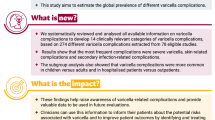Summary
A nationwide survey using questionnaires was carried out concerning lupoid hepatitis and related diseases (518 cases) during the 8-year period from January, 1975 to December, 1982. The following results were obtained.
-
1.
A total of 253 cases of autoimmune hepatitis, consisting of 97 lupoid hepatitis and 156 lupoid type CAH, were reported.
-
2.
Autoimmune hepatitis was overwhelmingly predominant in females, while male cases of B type CAH with a γ-globulin level of more than 2 g/dl significantly outnumbered female CAH cases of the same type.
-
3.
The liver function tests at the first examination demonstrated that transaminases, total bilirubin, ICG (R15) and γ-globulin were increased, and ChE was decreased in lupoid hepatitis. Lupoid type CAH showed a close similarity with lupoid hepatitis rather than to the nLnB type or B type with regard to liver function.
-
4.
Of the 289 patients who could be followed up, 280 cases (97%) received steroid hormones, and 247 (85%) received no another drug. Immunosuppressive treatment was also performed in 40% of the HBs antigen-positive cases of B type CAH.
-
5.
The efficacy was about 90% in the lupoid hepatitis group as well as in the lupoid type CAH group. It was no greater than approximately 70% in any other group.
-
6.
Analysis of survival revealed the following: 1) The cumulative survival rates of autoimmune hepatitis was lowest among the different types of CAH. 2) Patients who had a high serum level of total bilirubin tended to die sooner than those who had a low level. There was no correlation between the cumulative survival rate and serum γ-globulin concentration or antinuclear antibody titer. 3) The duration of steroid hormone therapy and the total dosage of immunosuppressants were thought to be important factors affecting the prognosis of autoimmune hepatitis.
Similar content being viewed by others
References
Good RA: Plasma cell hepatitis and extreme hypergammaglobulinemia in adolescent females. Am J Dis 92: 508, 1956
Read AE, Sherlock S, et al: Active juvenile cirrhosis considered as part of a systemic disease and the effect of corticosteroid therapy. Gut 4: 378, 1963
Mackay IR, et al: Autoimmune hepatitis. Ann New York Acad 124: 767, 1965
Mackay IR, Taft LI, et al: Lupoid hepatitis. Lancet2: 1323, 1956
Meyer zum BuschenfeldeKH, et al: The liver specific antigen purification and characterization. Clin Exp Immunol 10: 89, 1972
Mizoguchi Y, et al: Immunological studies on the chronic hepatitis. J Jpn Soc Intern Med 69: 1609, 1980 (Jpn)
Sherlock S: Active chronic hepatitis. The liver, by Gall EA, Mostofi FK. Williams & Wilkins Co Baltimore, 1973, p 342
Kenny JF, et al: Effect of estradiol on immune competence: in vivo and in vitro studies. Infect Immun 13: 448, 1976
Author information
Authors and Affiliations
Rights and permissions
About this article
Cite this article
Monna, T., Kuroki, T. & Yamamoto, S. Autoimmune hepatitis: The present status in Japan. Gastroenterol Jpn 20, 260–272 (1985). https://doi.org/10.1007/BF02774713
Received:
Accepted:
Issue Date:
DOI: https://doi.org/10.1007/BF02774713




